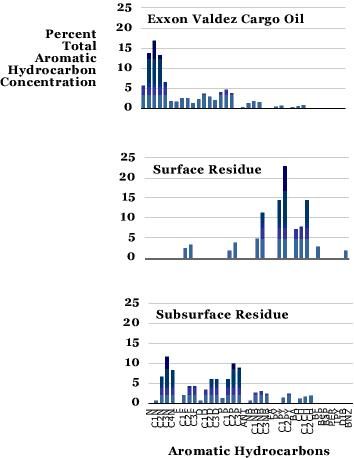What Is Weathering?
Oil is a mixture of many different chemicals. Not only does each of these have its own toxicity, but each also behaves differently in the environment and can affect the overall behavior of the mix.
When oil spills, the physical and chemical characteristics of oil interact with the physical and biochemical features of the habitat where a spill occurs. These factors determine how the oil will behave and ultimately what will happen to it.
- Some oil components are much more volatile than others, and so they tend to evaporate more rapidly when oil is spilled.
- Some are more easily broken down by microbes on the beaches.
- Sunlight can also degrade oil components.
- Chemical changes in the oil affect the physical features like density and viscosity (how easily it flows).
The sum of these physical and biological processes results in what we call "weathering" of the oil, reflected in the changes in chemical composition and physical characteristics over time. The more closely the chemical composition of an oil residue resembles that of the unspilled source oil, the "fresher" it is.
In Prince William Sound, Alaska, NOAA chemists report that the remaining oil from the 1989 Exxon Valdez spill ranges from very weathered to relatively fresh—even after more than two decades in the environment.

To the right are three graphs showing the chemical composition of the fresh Exxon Valdez crude oil and two different oil residues found at NOAA study sites in Prince William Sound. One residue sample, which bears little resemblance to the original oil, shows a highly weathered material. The other, still quite different from the cargo oil, nonetheless retains more of the compounds found in the original product and so is considered as less weathered.
What does this mean? In general, we have found that the more exposed to the elements the oil is, the more rapidly it weathers. Accordingly, the least weathered oil we can still find is the subsurface, or buried residues. In Prince William Sound, the relatively fresher oil is buried and has been protected from normal weathering processes by groundwater flow and other natural processes.
Fingerprinting Oil
The chemical composition of oil found in the environment also yields important clues about its origin. The process of determining where a hydrocarbon residue originated is known as "fingerprinting."
Most of the hydrocarbon residue we find at our Prince William Sound study sites originated with the Exxon Valdez spill. Other potential sources we have identified include diesel fuel from boats working in the area, non-specific combustion sources that could include anything from wood stoves to vessel exhaust, and spilled oil not linked to the Exxon Valdez.
While some natural oil seeps are known to exist near Prince William Sound, they are not believed to be a significant source relative to the large volume spilled in 1989. However, in some areas of the world, like the Gulf of Mexico, many oil seeps are known to release petroleum and natural gas into the water. This can complicate the assessment of oil spill impacts but serves to emphasize the importance of the chemical fingerprinting process.
Related
How Toxic Is Oil? Learn about some ways that oil can cause harm to living organisms.
Oil Types: Find out more about different kinds of oils and how they can behave differently when spilled in the ocean.
 An official website of the United States government.
An official website of the United States government. 